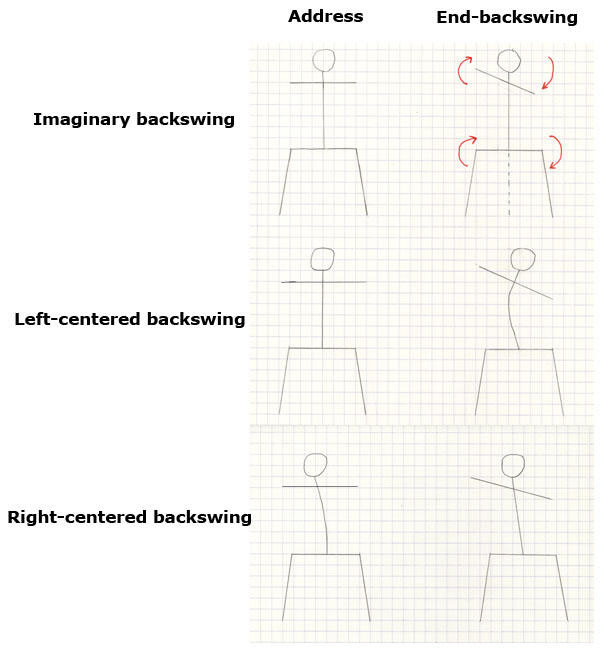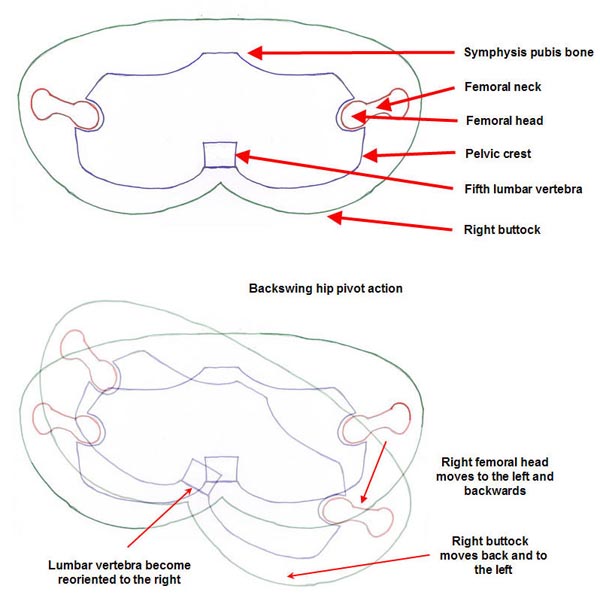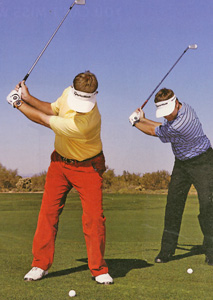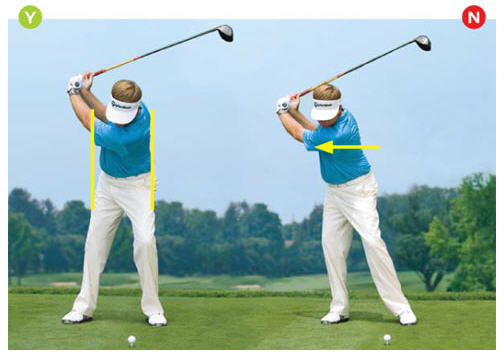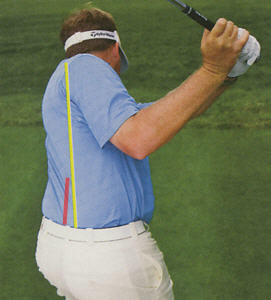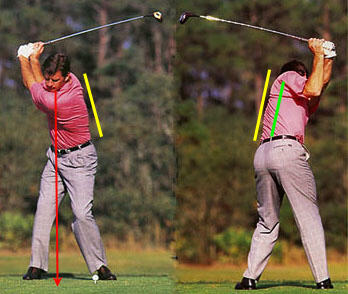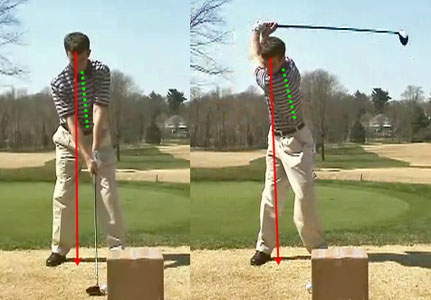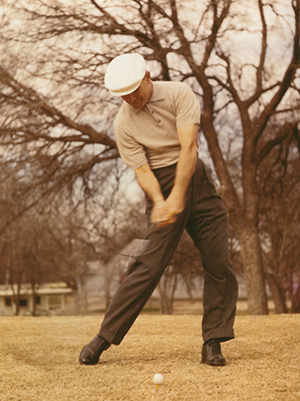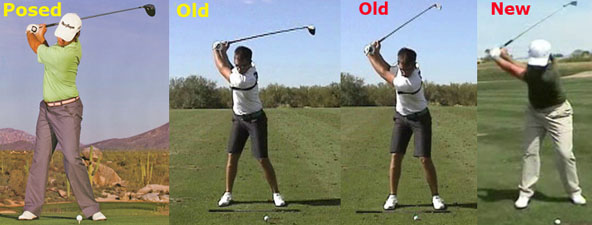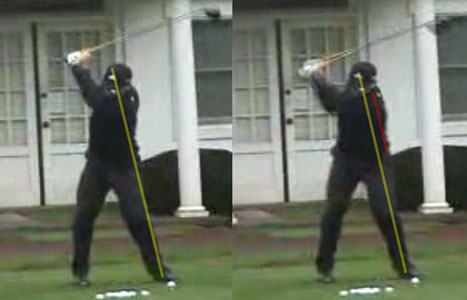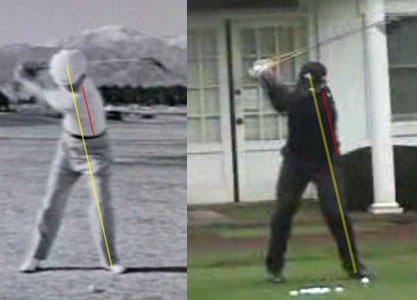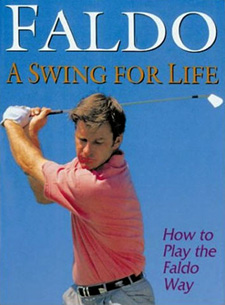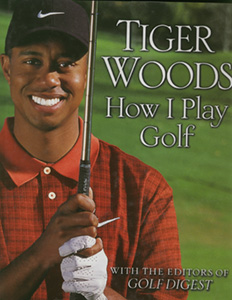Optimal Weight Shift in the Full Golf Swing
Click here to go back to the index page.
In my series of review chapters on different facets of the modern golf swing, I deliberately decided to represent the opinions of many golf instructors/teachers, and I deliberately avoided interjecting too many of my personal opinions in the golf instructional material. In this paper, I will adopting a contrary approach, and I will only be be representing my personal opinion, and I will not be representing the position of any other golf instructor/teacher. Regular readers of the golf instructional material on my website should be able to readily decide whether my personal opinions have merit. I have coined the terms "leftwards-centered backswing", and "rightwards-centered backswing" for this paper and I hope that those terms offer beginner golfers deeper insights into the complexities of a centralised backswing swing style.
Introduction:
Although this paper is titled "Optimal Weight Shift in the Full Golf swing", the main focus of this paper is going to be on the best method of executing a centralised golf swing. I define a centralised golf swing as a swing where the torso pivots/rotates within the vertical limits bounded by both inner feet. I first starting thinking deeply about a centralised golf swing when I read Bennett/Plummer's article on their Stack&Tilt swing [1]. After thinking about the issue of a centralised golf swing over an extended period of time, I finally decided that there is more than one type of centralised backswing. I regard the S&T swing as having a leftwards-centered backswing, while the traditional golf swing uses a rightwards-centered backwing. I will describe the differences between a leftwards-centered and a rightwards-centered backswing at great length in the main section of this review paper, but I will provide a capsule-summary for readers who only want to understand the main differences between a leftwards-centered and a rightwards-centered backswing.
I have produced this diagram to demonstrate what happens to the spine and head in a centralised backswing - both left-centered and right-centered.
Diagram demonstrating the movement of the spine and head during a centralised backswing
In the top series of images labelled "Imaginary Backswing", I have created a stick diagram of a golfer at address and at the end-backswing position. This imaginary backswing represents what probably occurs in a beginner golfer's mind when he envisages a centralised backswing movement. At address, he imagines the golfer standing tripod-like, with the spine central and straight, and the head above the center of the stance. Then during the backswing, he imagines that a golfer, who has a centralised backswing, will rotate his pelvis and torso around the central axis (represented by the spine and the dotted line, which is an imaginary extension of the spinal axis down to the ground) so that the head will remain vertically above a straight spine that is line with the center of the stance. However, although the shoulders can rotate around a centralised spinal axis, it is not anatomically possible for the pelvis to rotate around a central axis - because the pelvis is supported by two legs, and there is no central axis of rotation for the pelvis. The pelvis cannot really rotate - it can only pivot.What happens when the pelvis pivots in the backswing?
Cross-sectional diagram of the body at the level of the mid-pelvis
This second diagram demonstrates what happens to the pelvis when the golfer pivots over the right leg during the backswing. The right femoral head and right hip socket are driven rearwards and leftwards and that causes the right buttocks/right pelvis to move rearwards and leftwards. That movement of the pelvis causes the lumbar spine to become reoriented to the right. Because the lumbar spine is anatomically incapable of tilting/rotating, when the lumbar spine becomes reoriented to the right, the entire lumbar spine must acquire a rightwards tilt.
Now consider what happens in a leftwards-centered backswing golfer (see first diagram). At address, the golfer stands vertically straight, so that the head and straight spine are vertically above the center of the stance. Then during the backswing pivot action, the golfer attempts to keep his head and upper swing center (midway between the shoulders) vertically above the center of his stance. However, it is not anatomically possible to keep the spine perfectly straight during this maneuver. The lumbar spine acquires an obligatory rightwards tilt as a result of the pelvis pivot movement, and the golfer will need to toque-tilt his mid-upper thoracic spine leftwards in order to keep the head and upper swing center centralised. A leftwards-centered backswing golfer cannot avoid having a leftwards tilt of the mid-upper thoracic spine and upper torso at the end-backswing position - if he wants to keep the head and upper swing center perfectly centralised between his feet. I have called this centralised backswing swing style left-centered because the spine and upper torso have to tilt to the left in order to keep the head vertically above the center of the stance, and the left side of the head must end up in front of the center of stance if the head remains perfectly centralised.
Now consider what happens in a rightwards-centered backswing golfer (see first diagram). At address, the golfer deliberately adopts a slight rightwards tilt of the spine (approximately 4-6 degrees) position and he doesn't try to keep the head centralised between the feet. Note that the lumbar spine cannot tilt rightwards at address if the pelvis is perfectly square to the ball-target line, so the rightwards tilting of the spine only involves the thoracic/cervical spine. The rightwards tilt of the spine at address causes the head to be slightly behind the center of the stance. During the backswing, the lumbar spine acquires an obligatory rightwards tilt as a result of the pelvis pivot movement, and the golfer simply lets his thoracic and cervical spine align itself naturally/automatically straight in line with the lumbar spine. At the end-backswing position, the golfer has a straight spine that is tilted to the right. Note that the head has remained stationary and there is no swaying of the head/spine/upper torso to the right during the rightwards-centered backswing. The head is still vertically above the same point on the ground at the end-backswing position - compared to the address position. I think that having a straight spine, that is rightwards-tilted at the end-backswing position, and having the head behind the center of the stance offers many biomechanical advantages, which I will describe in great detail in the main section of this paper.
Main section of the paper:
This paper deals with the important problem-question of "the optimal amount/degree of weight shift that should occur in the backswing and downswing" when a golfer executes a full golf swing with a long iron or driver. Although I will briefly discuss short iron shots at a later point in this paper, a reader must realise that this paper is primarily focused on the best method of executing a centralised backswing for long iron and driver shots.What do I mean by weight shift? When one talks of weight shift with respect to a golfer moving in space, one primarily thinks of the centre-of-gravity (COG) of the body as an unit, or the COG of the upper torso, or COG of the lower torso, moving sideways during the golf swing. I will not discuss any rearwards weight shift (movement the COG of the body away from the ball-target line, towards the tush line) in this paper, and I will only be discussing the sideways (lateral) movement of the body during the backswing and downswing.
If one looks at a beginner golfer, who has just started to play golf, one will frequently notice that he sways his body during the full golf swing. During the backswing, he will often sway the body to the right (away from the target), and during the downswing he will sway the body to the left (towards the target) - in synchrony with the movement of the arms across the front of the body. That means that the upper swing center, midway between the shoulders and approximately at the level of the seventh/lowest cervical vertebra, is moving rightwards/backwards (away from the target) during the backswing, and leftwards/forwards (towards the target) during the downswing. That sideways movement of the upper swing center (which many golf instructors think is the central hub of the arm swing arc) partly explains why there is little likelihood of the beginner golfer having a consistent clubhead swingarc that bottoms out at exactly the same spot on the ground in repeating swings. Imagine the movement of the pendulum of a grandfather clock, and consider what would happen if the fulcrum of the pendulum continuously moved sideways during its pendular swingarc. It is very unlikely that the bottom of the swingarc of the pendulum would consistenly be at the same spot in space. A beginner golfer would benefit if he mimiced the consistent pendular swingarc of a grandfather clock - in the sense of having a clubhead swingarc that is very consistent, and where the clubhead touches the ground at exactly the same spot in repeating full swings. To achieve that goal, a beginner golfer must minimise sideways swaying of the upper swing center during the golf swing. How is that best achieved?
Bennett/Plummer, originators of the Stack&Tilt swing (S&T swing) [1], believe that a golfer should have a centralised swing, and they believe that a golfer must avoid any weight shift to the right during the backswing.
End-backswing position - S&T swing versus traditional swing [1]
This photograph offers a visual comparison between the S&T swing (golfer in yellow/red) and a version of the traditional golf swing (golfer in blue) at the end-backswing position. Note that the S&T golfer has kept his head and upper swing center vertically over the ball during the backswing, while some traditional golfers move the head and upper swing center far behind the ball, and far away from the center of his stance, during the backswing. Bennett/Plummer claim that any swaying of the upper body/head to the right should be avoided and they believe that a golfer should have a centralised swing. They demonstrate a centralised swing in the following photograph.
Centralised S&T swing [1]
In this photo, the centralised S&T swing is represented on the left (Y). Note the two yellow lines drawn vertically in line with inside border of both feet. Bennett/Plummer recommend that the torso should rotate during the backswing, so that the entire torso remains between the yellow lines (between the feet) during the backswing. They label this swing pattern a centralised swing, and they do not want any lateral swaying of the upper torso to the right during the backswing, as seen in the golfer on the right (N), whose head is vertically above his right foot as a result of excessive lateral shift of the upper torso to the right. I agree that it is a major mistake if a golfer sways to the right during the backswing, and I am very much in favor of a centralised backswing, where the torso rotates within the limits of the inner boundary of both feet. However, there are two types of centralised backswing - a leftwards-centralised backswing and a rightwards-centralised backswing. The S&T swing is a leftwards-centralised backswing, and I much prefer a rightwards-centralised backswing. Before I explain why I prefer a rightwards-centralised backswing, let me explain the differences between a rightwards-centralised backswing and a leftwards-centralised backswing. I will first describe the leftwards-centralised S&T swing.Leftwards-centralised backswing
If one looks at the S&T swing in the above photograph, you may understand why I label it a leftwards-centered backswing. The golfer is putting more weight on the left leg during the backswing, and he is also leaning his left upper torso to the left by deliberately executing a reverse pivot positional maneuver. A reverse pivoting positional maneuver is present when a golfer has upper torso tilt to the left to such a degree that the left-side of the head moves in front of the center of the stance, +/- in front of the ball if it is positioned near the center of the stance. What causes the leftwards tilt of the upper torso to the left in the S&T swing?
Consider the appearance of a S&T golfer as viewed from behind.
Back view of S&T golfer at the end-backswing position [1]
When a S&T golfer performs a backswing pivot movement, it is very similar to the traditional backswing pivot movement in the sense that the right femoral head moves to the left and slightly rearwards (towards the tush line) as the golfer pivots over the right leg. That causes the pelvis to rotate clockwise as viewed from above (right hemi-pelvis moves backwards/leftwards, while the left hemi-pelvis moves forwards/rightwards), and that causes the lumbar vertebra to become reoriented towards the right (front surface of the lumbar vertebra face rightwards) - as explained in great detail in my pivot paper. The lumbar spine is structurally incapable of rotating sideways, and if the lumbar vertebra are reoriented to the right (secondary to the rotational movement of the pelvis), then the entire lumbar spine will tend to be oriented/tilted to the right. That can be seen in the above photo of a S&T golfer (represented by the faint red line). However, it is possible to torque-tilt the thoracic spine to the left if a golfer leans the upper torso to the left while rotating the shoulders around the spine. You can see that phenomenon in the above photograph - the yellow line delineates the approximate left-leaning position of the upper torso. A S&T golfer is instructed to keep his head, and upper swing center, vertically above the ball at address, and also during the backswing, and that goal is only achievable if the S&T golfer torque-tilts the mid-upper thoracic spine to the left.The leftwards torque-tilt of the mid-upper thoracic spine AND the left-leaning appearance of the upper torso AND the fact that the left-side of the head is in front of the center of the stance - represent a leftwards-centralised backswing.
Rightwards-centralised backswing
I am going to present a few examples of a rightwards-centralised backswing, which is the centralised backswing approach adopted by the majority of PGA tour golfers (eg. Tiger Woods, Ben Hogan, Nick Faldo, Adam Scott, Trevor Immelman, Justin Rose, Luke Donald, Stuart Appleby, Annika Sorenstam).
There are a number of features that characterise golfers who utilise a rightwards-centralised backswing. First of all, they uniformly have a small degree of rightwards spinal tilt at address, which causes the left-side of their head to be behind the ball at address. They then perform a standard backswing pivot movement without torque-tilting their mid-upper thoracic spine to the left during the shoulder rotational movement - instead, they simply allow the thoracic spine to naturally/automatically reorient itself in response to the backswing pelvic pivot movement's effect on the lumbar spine.
Consider an example of a rightwards-centered backswing.
Nick Faldo - end-backswing position [2]
Note that Nick Faldo keeps his right knee slightly flexed as he pivots over his right leg, and the "fixed" knee position prevents lateral swaying of the right thigh and pelvis during the backswing. Note that the hip pivoting action is similar to the S&T backswing pivot action, except that Bennett/Plummer favor a more straightened right leg which pushes the pelvis more laterally to the left. The end-result is very similar in terms of the positional movement of the right femoral head, and the consequent movement of the pelvis (right hemi-pelvis moves backwards/leftwards while the left hemi-pelvis moves forwards/rightwards). Note that the lumbar spine becomes oriented to the right to roughly the same degree as seen in the S&T swing. The major difference lies in the orientation of the thoracic spine - Nick Faldo allows his thoracic spine to naturally align itself in sympathetic/straight alignment with the lumbar spine, so that the entire spine has a natural rightwards tilt (green line). That causes the upper torso to have a slope to the right (yellow line). If the head moves slightly to the right so that it remains in natural alignment with the rightwards tilted spine, you can see the end-result - a vertical line drawn from the center of the head hits the ground inside the right foot, behind the center of the stance, and well behind the ball. Note that Nick Faldo has a centralised swing, because his mid-upper torso is rotating within the space vertically-bordered by the inner borders of his feet. However, he has a rightwards-centered backswing in the sense that his upper torso has a rightwards tilt at the end-backswing position and the left-side of the head is behind the center of his stance, and well behind the ball.
The rightwards tilt of the mid-upper thoracic spine AND the right-leaning appearance of the upper torso AND the fact that the left-side of the head is behind the center of the stance - represent a rightwards-centralised backswing.
Consider another example of a rightwards-centered backswing. The golfer is Mike Finney, who has the most beautiful golf swing that I have ever seen. He looks like he is in perfect balance throughout the entire swing, and he remains perfectly centralised between his feet throughout the entire backswing and downswing. He exhibits no lateral swaying movements, and he rotates his torso within the vertical limits of the inner border of both feet.
See Mike Finney's swing video - http://vimeo.com/22638381
Why do I label Mike Finney's backswing as being rightwards-centered?
Mike Finney - capture images from his swing video
In the left image, one can see MikeFinney at address. Note that he has small degree of rightwards spinal tilt at address (green dotted line) and that his head is behind the center of his stance (red-arrowed line). Note that his head doesn't move during the backswing, and that his head is still vertically above the same point on the ground at the end of his backswing. The green dotted line shows the rightwards tilt of his spine and upper torso at the end-backswing position. Mike Finney has a very rotatory swing with no lateral shift of his mid-upper torso to the right during the backswing. During the backswing, he makes no attempt to change the degree of spinal tilt that he adopted at address, and he simply rotates his mid-upper torso around his rightwards tilted spine, without making any deliberate weight shift movements .The following composite photograph of Stuart Appleby's rightwards-centered swing demonstrates the approximate degree that the head sometimes moves in a rightwards-centered swing.
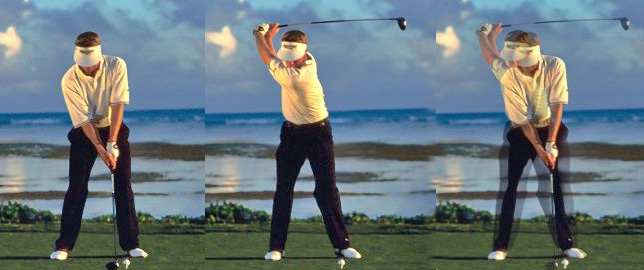
Stuart Appleby - capture images from a swing video
At address, Stuart Appleby has slight rightwards spinal tilt which causes his head to be behind the center of his stance (image 1). At the end-backswing position, you can note that he has rotated his mid-upper torso within the vertical limits of his inner feet, and that he has roughly the same degree of rightwards spinal tilt as he had at address (image 2). Image 3 is a composite image of images 1 and image 2, and you can see that there is no lateral shift of his torso to the right. His head has moved slightly to the right, but that is mainly due to rotation of the head at the atlanto-axial joint (joint between the first and second cervical vertebra). If the head swivels slightly to the right during the backswing, it doesn't necessarily imply that the cervical spine has shifted laterally to the right. The upper swing center (point midway between the shoulders) is roughly at the level of the lowest cervical vertebra (7th cervical vertebra) and there is no appreciable lateral shift of the upper swing center in Stuart Appleby's backswing.
What is the appearance of a rightwards-centered backswing - when viewed from above?
The following composite photograph of Tiger Woods' rightwards-centered swing demonstrates the movement of his torso and head as seen from above.
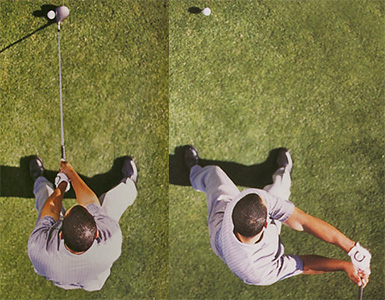
Tiger Woods backswing - from reference [3]
At address, Tiger Woods has a small degree of rightwards spinal tilt, which causes the left-side of his head to be behind the ball at address (image 1). During his backswing, Tiger Woods simply rotates his mid-upper torso without attempting to alter his spinal tilt angle (image 2). Note that his head swivels slightly to the right, so that it is behind the center of his stance at the end-backswing position. One can see that his mid-upper torso rotates within the vertical limits of his inner feet, and that he has a centralised backswing. However, one can see that he has a rightwards-centered backswing - because he has rightwards tilt of the mid-upper thoracic spine AND a right-leaning appearance of the upper torso AND the left-side of the head is behind the center of his stance.
What are the advantages of a rightwards-centered backswing?
I think that there are major advantages to a rightwards-centered backswing, as compared to a leftwards-centered backswing.
Consider the following sequence of photos of Ben Hogan's downswing.
Ben Hogan downswing sequence - capture images from a swing video
Image 1 shows Ben Hogan at the end-backswing position- note that he has all the defining features of a rightwards-centered backswing (rightwards tilt of the entire thoracic spine, right-leaning appearance of the upper torso, and a head position that is right of the center of his stance).I think that Ben Hogan is in a perfect end-backswing position to allow him to generate a powerful, and perfectly balanced, downswing. I believe that the head and left foot are key stabilising points during a powerful body-powered downswing. Note how Ben Hogan keeps his head near-stationary during the entire downswing, and note that his body is essentially pivoting/rotating around an imaginary axis between two stabilising points - his head and left foot. During the early downswing, Ben Hogan shifts his pelvis laterally to the left, so that he can replant weight on a straightening left leg. Although there has been a significant amount of lateral pelvic shift by impact, note that the outer border of his left pelvis never gets left of the inner border of his left foot. That is a critical point and implies a "firm left side". If the pelvis slides beyond the vertical confines of the left foot, then it represents a less stable, less powerful, impact alignment. A major advantage of adopting a rightwards-centered backswing is the fact that one has already adopted the optimum body-alignment required at impact (rightwards spinal tilt = secondary axis tilt), and there is no need for any accessory body movement to create a rightwards spinal tilt (secondary axis tilt) during the downswing. One merely has to replant weight on the left foot, and shift the pelvis/lower torso far enough to the left to allow the torso to pivot leftwards over a straightening, and firmly-supportive, left leg, while still keeping the upper swing center behind the ball. The second major advantage of a rightwards-centered backswing is that one can perform this lateral shift while still keeping the entire pelvis to the right of the inner border of the left foot, which means that the pelvic pivoting motion (left hip clearing action) in the downswing is still centered between the feet. If the pelvis slides left of the inner border of the left foot, then the pelvis cannot pivot to the left in a stable, and still-centered, manner (against a "firm left side").
Consider the implications of having a leftwards-centered backswing.
Here is a photograph from Bennett/Plummer's part 2 article in Golf Digest.
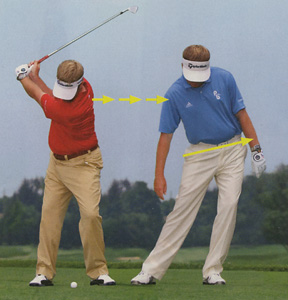
Hip shift maneuver in the S&T swing - from reference [1]
The red-shirted golfer is demonstrating the end-backswing position of a S&T golfer. Note he has all the features of a leftwards-centered backswing - leftwards torque-tilt of the mid-upper thoracic spine; left-leaning appearance of the upper torso; and the left side of the head is in front of the center of the stance. How does a leftwards-centered backswing golfer get secondary axis tilt away from the target (rightwards tilt of the spine/upper torso) by impact? There are only two possible solutions - i) tilting the upper torso away from the target during the downswing without moving the pelvis laterally to the left, or ii) shifting the pelvis laterally to the left during the downswing, while keeping the upper torso/head stationary. Bennett/Plummer correctly state that a golfer should not move his upper torso away from the target during the downswing, and they therefore recommend the second solution. Image 2 in the above photo demonstrates the lateral shift of the pelvis that Bennett/Plummer recommend - which is needed during the downswing to create a rightwards spinal tilt (and rightwards upper torso tilt) by impact. Bennett/Plummer describe this lateral pelvic shift maneuver as a hip thrust, or hip jumping-up maneuver, whereby the butt muscles thrusts the pelvis under the lumbar spine thereby reversing the overall tilt of the spine from a leftwards-tilted spine to a rightwards-tilted spine. This pelvic thrust maneuver is an accessory maneuver that is not required if a golfer adopts a rightwards-centered backswing. The disadvantage of any accessory biomechanical maneuver is that is creates a "timing" problem, and that additional timing-variable can potentially create swing-by-swing inconsistency problems. More importantly, consider what has to happen during this lateral pelvic thrust maneuver.With reference to the S&T swing, Bennett/Plummer make the following recommendations. They recommend that the weight distribution at address should 60:40 favor the left side. Then, during the backswing, they recommend that the S&T golfer should put more weight on the left side, partly by shifting the pelvis more over to the left side. This is accomplished by performing a backswing pivot motion around a straightened right leg, which is also angled to the left, and this backswing pivot maneuver helps thrust-shift the entire pelvis over to the left side. You can see that phenomenon in the above photo - note that the outer border of the left pelvis is already outside the vertical limit of the inner border of the left foot at the end-backswing position. Compare that situation to Ben Hogan's end-backswing position in his rightwards-centered backswing (see Ben Hogan photo above) - and note that the outer border of Ben Hogan's left pelvis is well inside the vertical limit of his left inner foot. Bennett/Plummer state that the downswing must start with a lateral shift of the pelvis to the left, which means that the outer border of the left pelvis must move even further outside the vertical limit of the inner border of the left foot - as demonstrated in the above photograph. If the outer border of the left pelvis is that far outside the inner border of the left foot at impact, then it doesn't represent a "firm left side" or a still-centered downswing pelvic pivot movement. I believe that this necessary pelvic-shift phenomenon is a major potential disadvantage of a leftwards-centered backswing - the fact that the pivoting golfer's lower body cannot easily remain within the vertical limits of both inner feet during the downswing.
Compare that situation to Ben Hogan's swing.
Ben Hogan in the late downswing as he nears impact - from reference [4]
One can not only sense the power in Ben Hogan's driver downswing - one can also sense that he is in perfect balance because i) his pelvis is centered between his feet (outer border of the left pelvis is well within the vertical limit of the left inner foot), and ii) he has a "firm left side" to support his powerful downswing action. Theoretically, that is not possible if a golfer starts off with a left-centered backswing posture, and then has to thrust the pelvis even more laterally to create the correct body-alignments (rightwards tilted upper torso) by impact.Unfortunately, I do not have a swing video of a left-centered backswing golfer hitting a driver. Although many PGA tour golfers have been taught by Bennett/Plummer, they do not seem to have a left-centered backswing movement in "real life". For example, Aaron Baddeley is regarded as being the poster-child of Bennett/Plummer's S&T swing style, and although he has a left-centered backswing in his posed photograph in the Golf Digest article (see photo below), he does not exhibit a left-centered backswing when playing in the PGA tour.
Aaron Baddeley end-backswing comparison
Note that Aaron Baddeley has a leftwards-centered backswing in his posed photo (image 1) - derived from the Golf Digest article [1]. However, I have never seen a capture image from a swing video of any of his online-available PGA tour swings that demonstrates him leaning to the left to such a degree that the left-side of his head is in front of the center of his stance. The 4th image in the above composite photograph demonstrates his new swing - and it has all the characteristics of a rightwards-centered backswing. In his new swing, Aaron Baddeley does have a more straightened right leg and he does put slightly more weight on his left leg at the end-backswing position - but his spine and upper torso are definitely tilted to the right and the left-side of his head is definitely behind the center of his stance (similar to his old swing).Here is an online swing video of Aaron Baddeley's new swing.
http://www.youtube.com/watch?v=cPOA8whY2ts
Look at the frontal view of his swing (first swing video sequence). Note that he has his head behind the ball at address and note that his head is behind the center of his stance - due to a slight degree of rightwards spinal tilt at address. Note that he has definite rightwards tilt of his upper torso at the end-backswing position, and that his head remains stationary during the backswing and that it remains well behind the ball. I think that Aaron Baddeley has a classical rightwards-centered backswing swing style in this swing video.
I have found one swing video of a S&T golfer who demonstrates a leftward-centered backswing - as seen from behind.
Capture image sequence of Mike McNary's swing [5]
This swing sequence is from his first swing. I have placed two red dots - one over the upper swing center (midway between the shoulders) and the other over the lower swing center (midway between the hips). I have also placed a red line alongside the outer border of his left hip at the end-backswing position.Note that Mike McNary attempts to keep his two swing centers vertically over the ball at the end-backswing position by leaning his upper torso over to the left - and that he also pushes his pelvis slightly to the left and puts more weight on his left leg during the backswing. Note that the outer border of his left pelvis is outside the vertical limits of his left inner foot at the end of the backswing. Then, note how he executes the downswing. To get a rightward spinal tilt at impact, he has to thrust his pelvis laterally to the left (his butt muscles have to push his pelvis under his lumbar spine) while he keeps his upper torso stationary. Note how the outer border of his left pelvis and left thigh is well outside the inner border of his left foot as he nears impact (image 6). I regard this impact position as being potentially less stable/less powerful than Ben Hogan's impact position. Mike McNary is hitting a short iron (or mid-iron) and he does not have to swing as hard as a golfer would need to swing if he were hitting a driver. Therefore, he can easily hit very solid short iron shots (as can readily be seen when viewing his online swing video), but hitting short irons is very different to hitting long irons and a driver. A beginner golfer needs to decide whether he can hit very solid shots with a sense of power AND a sense of balance while utilising a leftwards-centered backswing style (as compared to a rightwards-centered backswing style) - when hitting a driver or long iron.
(* Interesting point - if you look at the swing video of MikeMcNary's golf swing, you will note that he performs three swings. In the first swing, you will see him deliberately/consciously make a left-tilting move when he addresses the ball, and that "move" gets more weight over his left foot and gets his upper torso to lean to the left. In other words, he makes that deliberate move to ensure that he has a leftwards-centered backswing. Most importantly, note that he does not perform that same move in his second and third swings, and I think that he actually has a rightwards-centered backswing during the second and third swings. This phenomenon suggests that Mike McNary has a natural tendency, like most good golfers who have a centralised backswing style, to have a rightwards-centered swing style and that is he is deliberately forcing himself to adopt a leftwards-centered swing style because he has come to believe that it is a better choice. However, it could be that he is really choosing between a centered versus non-centered backswing style, and that he is not fully aware of the other centralised backswing swing style option - a rightwards-centered backswing swing style.) There is no biomechanical advantage to torquing one's thoracic spine over to the left during the backswing, and a golfer can hit solid short iron shots with a spine that remains in its natural alignment - thoracic spine straight-aligned in line with the rightwards-oriented lumbar spine.
The purported advantage of a S&T swingstyle is that there is no weight shift to the right during the backswing, and Bennett/Plummer argue in their Golf Digest article [1] that it allows a golfer to avoid hitting fat shots (hitting the ground behind the ball), which they claim is more likely to happen if a golfer moves his weight to the right during the backswing. However, Bennett/Plummer are comparing the S&T swing style to a golfer who sways rightwards off the ball during the backswing. They did not compare their S&T swing style to a rightwards-centered backswing swing style. I think that there is no reason why a rightwards-centered backswing golfer cannot hit solid shots, and I think that a rightwards-centered backswing swing style is suitable for both long irons and short irons.
Here is an example of Ben Hogan employing a rightwards-centered backswing swing style when hitting a short iron.

Ben Hogan hitting a wedge shot - from a 1956 swing video [6]
Note, that although the ball position is more centralised in his stance, that Ben Hogan still has sufficient rightwards spinal tilt at address (image 1) and at the end-backswing position (image 2) to ensure that the left-side of his head is behind the ball. Note the rightwards tilt of his upper torso and spine at the end-backswing position. Note that Ben Hogan doesn't have to thrust his hips to the left during the downswing in order to create a rightwards spinal tilt at impact, and that there is little increased lateral pelvis shift to the left during the downswing. He only needs to shift his pelvis a little to the left, so that he can pivot his lower body to the left over a straightened left leg (firm left side). Note that he has no difficulty getting his hands ahead of the ball at impact, and that he can easily hit down on the ball and produce a divot in front of the ball. I think that it is an error-of-knowledge if a beginner golfer believes that it is imperative to adopt a leftwards-centered backswing swing style for short-iron shots - if he wants to hit down on the ball. It is very easy to hit down on the ball using a rightwards-centered backswing swing style if one positions the ball correctly and places slightly more weight on the left leg during the backswing.In other words, although this paper is primarily about the "best" centralised backswing style for driver and long iron shots - the rightwards-centered backswing swing style, it is important that a beginner golfer realise that a rightwards-centered backswing swing style is also very suitable for short iron shots.
I have noticed, when reading through many online golf discussion forum posts on the S&T swing, that many beginner golfers state that they are hitting the ball more solidly when using the S&T swing. However, they have not been coached by a professional golf instructor who is well versed in the S&T swing methodology. They simply read the Golf Digest article [1], and decided to stay more centered duiring the backswing, which resulted in beneficial results. Without swing video evidence, we have no idea whether their "new" backswing is left-centered or right-centered, and we can only conclude from their anecdotal reports that a centered backswing is better than a non-centered backswing.
Another problem that occurs is that some golfers are using the S&T swing style to remedy another fault in their downswing action. Consider this downswing video commentary from a senior editor of Golf Digest magazine, who had a problem of hitting behind the ball (low point of his clubhead swingarc was behind the ball) and then flipping his clubhead past his hands at impact.
Peter Finch's commentary regarding his S&T swing lesson - http://www.golfdigest.com/instruction/swing/video/2007/07/stackandtilt
(* Note that you will have to view an obligatory commercial before you can view Peter Finch's commentary on his S&T swing lesson)
Note what Bennett/Plummer do to correct Peter Finch's problem. They push his torso over to the left, so that he is more weighted over the left side at address. That causes him to have a downswing that is steeper and that allows him to better compress the ball with a descending blow. However, that "new" approach is not necessarily the best solution to his fat shot/flipping problem. I think that Peter Finch's major problem was an inefficient downswing pivot action that didn't drive his hands through the impact zone, so that he would have forward clubshaft-lean at impact (as seen in the above photo of Ben Hogan hitting a wedge). I agree that Peter Finch should adopt a more centered backswing - but I think that it should be a rightwards-centered backswing. If he adopted a rightwards-centered swing and improved his downswing pivot action so that he hits through the ball (and not at the ball), then he could have gained the advantages of a centered backswing without the disadvantages - the disadvantage of having the outer border of his left pelvis actively move too far outside the vertical limit of his left inner foot at impact (note that he stated that he felt that he was losing his balance slightly during the downswing - and note how he falls towards the target in the followthrough). If he adopted a rightwards-centered backswing and improved his downswing dynamics, he would still be able to hit down on the ball - but he would not have to shift his pelvis as far over to the left during the downswing. In other words, I think that he could more effectively hit against a supportive "firm left side" and remain better balanced during the downswing if he adopted a rightwards-centered backswing.
Finally, many people do not understand the difference between the S&T's left-centered backswing and a right-centered backswing when viewing a golfer who appears to have a small degree of reverse pivoting at the end-backswing position.
Sergio Garcia - capture images from an online swing video
A number of people who look at Sergio Garcia's end-backswing position (image 1) claim that he has a S&T swing because his upper torso seems to be leaning to the left. However, Sergio Garcia does not have a leftwards-centered backswing. He has a rightwards-centered backswing with a shoulder rotation that is >90 degrees, and that greater degree of shoulder rotation torques his mid-upper thoracic spine so that the upper spine/torso is forced leftwards. Note that Sergio Garcia pivots over a slightly flexed right knee during the backswing, and he does not push his pelvis over to the left during the backswing (the outer border of his left pelvis is well within the vertical limit of his left inner foot at the end-backswing position). The yellow line (drawn between his head and left foot) depicts the postural fact that he potentially has the "correct" overall body alignment at the end-backswing position - the line is oriented to the right. Notice what happens when Sergio Garcia starts the downswing with a hip squaring action (image 2) - his right shoulder immediately moves to the right and he then has the typical body alignments that characterise a rightwards-centered backswing golfer (rightwards slope of the upper torso and spine + head behind the center his stance, and well behind the ball). At the start of his downswing, Sergio Gracia has very similar body alignments - compared to Ben Hogan at the start of his downswing.Here is a comparative photo of Sergio Garcia and Ben Hogan at the start of the downswing.
Comparison of Hogan and Garcia at the start of the downswing
Note, at the start of the downswing, that both Ben Hogan and Sergio Garcia have rightwards tilt of the upper torso (red line), a head position that is behind the center of the stance, a centered pelvis position (outer border of the left pelvis is inside the left inner foot), and a head-left foot axis (yellow line) that is significantly right-tilted. In other words, although Sergio Garcia had some left-leaning of his upper torso at the end-backswing position (due a >90 degree shoulder rotation that over-torques the thoracic spine to the left), that reverse-tilting appearance is immediately corrected at the start of the downwsing without any need for a hip thrust maneuver that may shift the outer border of the left side of the pelvis outside the vertical limit of the inside of his left foot.
Conclusion:
The fundamental theme of this paper is my personal opinion regarding the problem-question of "what is the optimal weight shift in the full golf swing".I can summarise my "personally opinionated" answer as follows.
1) The optimal weight shift in a full golf swing is a full golf swing style that is characterised by the least amount of unnecessary to-and-fro weight shift, and I think that this biomechanical goal is best achieved if a golfer adopts a centralised golf swing style. I think that a beginner golfer should avoid any lateral swaying of the torso during the backswing/downswing, because it will likely result in an inordinate amount of hand/clubhead swingarc inconsistencies from swing-to-swing. I think that a beginner golfer should attempt to rotate his entire torso within the vertical limits of both inner feet - during both the backswing and downswing. A beginner golf must realise that he doesn't gain any swing power by shifting laterally off the ball during the backswing, and maximum swing power can be achieved by utilising a centralised backswing - where the golfer pivots-rotates his torso within the vertical limits of his inner feet.
2) Regarding the magnitude of the weight shift, I think that beginner golfers should avoid thinking in terms of numbers. For example - the weight distribution at address may be 55:45 favoring the right side for a driver, 50:50 for mid-irons, and 55:45 favoring the left side for short irons. During the backswing, more weight must obviously move to the right side - not due to movements of the central torso, but due to the fact that both arms and the club move to the right of the center of the stance. It is not important to guesstimate how much weight is over the right foot at the end-backswing position (eg. 80%, 70%, 65%, 60%) because the absolute value is meaningless. A golfer should primarily think of rotating his torso between his feet using a centralised pivot-rotary movement that keeps his torso within the vertical limits of both inner feet, and he should not worry about the absolute magnitude of any weight redistribution that will accompany this torso movement. A golfer should make no attempt to shift any weight to the right during the backswing as a goal in itself, and any weight redistribution should be secondary to pivoting-rotating the torso in the "correct" manner - a manner that creates the optimum body alignments.
3) During the centralised backswing pivot-rotary movement of the torso, a beginner golfer should create optimum body alignments (optimum from a biomechanical perspective), and I have exhaustively explained why I think that the optimum body alignments are those featured in a rightwards-centered backswing - rightwards tilt of the spine/upper torso at address and at the end-backswing position (for all shots); a head position where the left side of the head is behind the center of the stance at address and at the end-backswing postion (for all shots), and a pelvis position where the outer border of the left pelvis is well within the inner border of the left foot at the end-backswing position (for long iron and driver shots).
If an individual beginner golfer thinks that a leftwards-centered backswing may be a bettter choice from a biomechanical perspective, then I think that he should personally justify his choice after repeatedly viewing Mike Finney's swing video [7] and asking himself why a leftwards-centered backswing swing style is better than Mike Finney's rightwards-centered backswing swing style. I am also very willing to post any "insightful personal reasons for this choice" in the "commentary, criticism and controversy" section of this paper.
Jeff Mann.
October 2007.
References:
1. The New Tour Swing. June 2007 issue of the Golf Digest.
Introduction - http://www.golfdigest.com/instruction/2007/06/stackandtilt_gd0706
How it works - http://www.golfdigest.com/instruction/2007/06/stackandtilt1_gd0706
Part 2: Slideshow lessson - http://www.golfdigest.com/instruction/stackandtilt
2. A Swing For Life. Nick Faldo.
3. How I Play golf. Tiger Woods.
4. The Fundamentals of Hogan. David Leadbetter.
5. Mike McNary swing video on Utube.
http://www.youtube.com/watch?v=4Jm71JpO01U
6. The Magic Golf Swing of Ben Hogan - filmed in Mexico in 1956.
http://youtube.com/watch?v=yrHrgxwd-OQ
7. Mike Finney Driver Swing Video.
